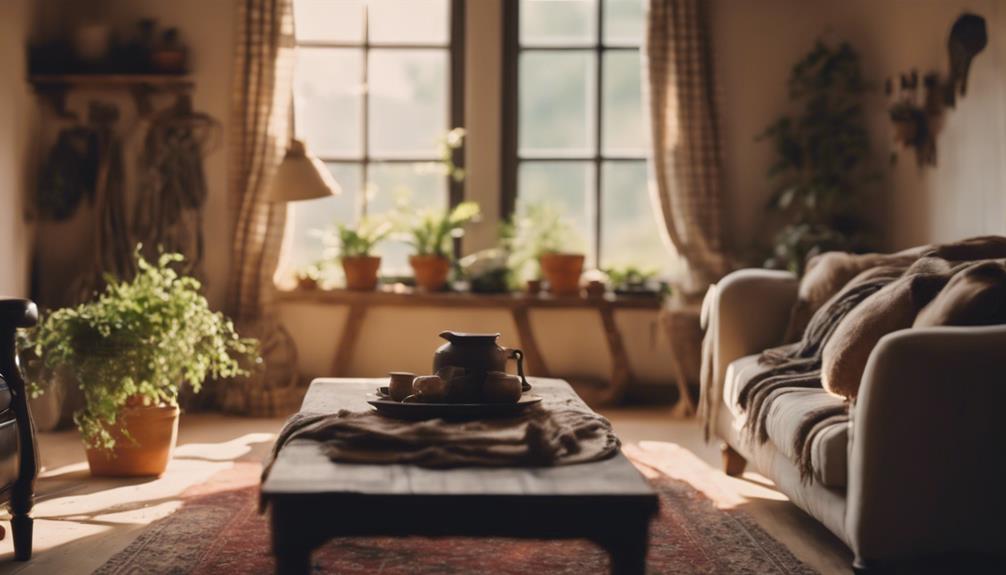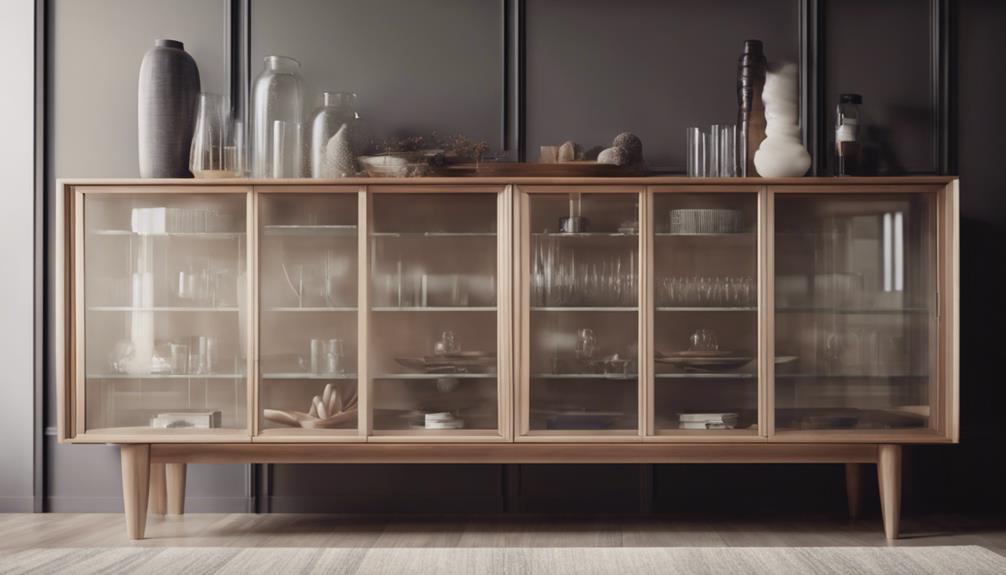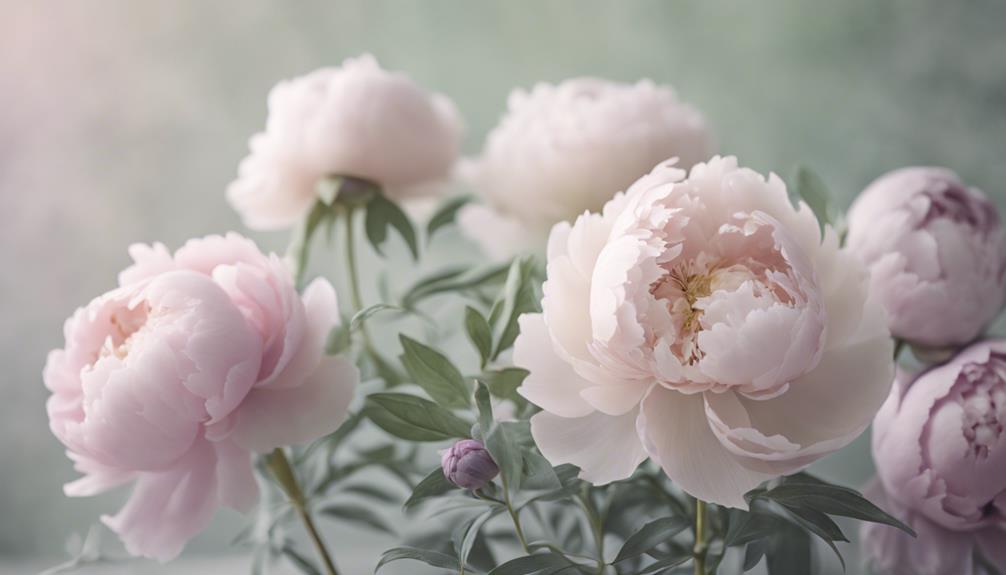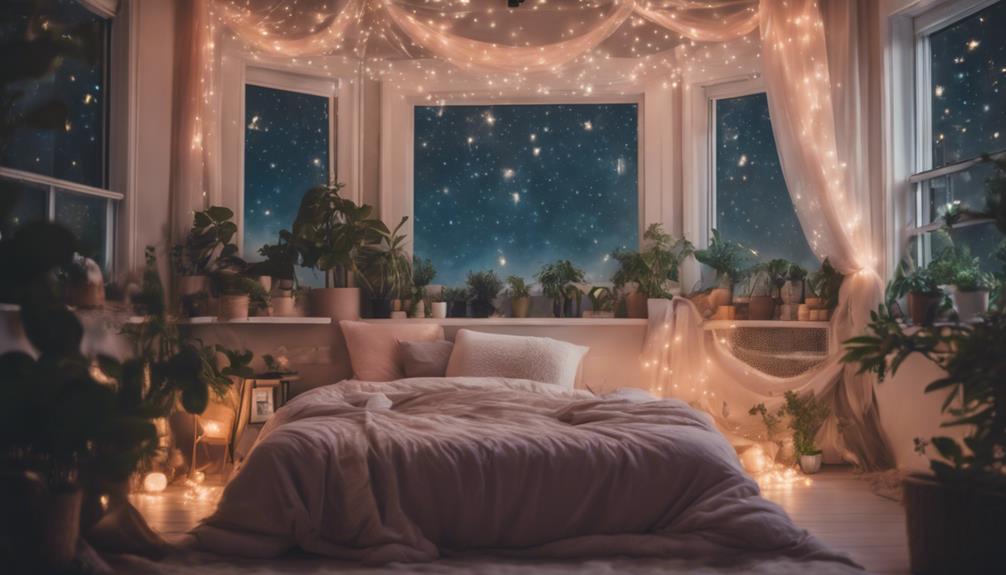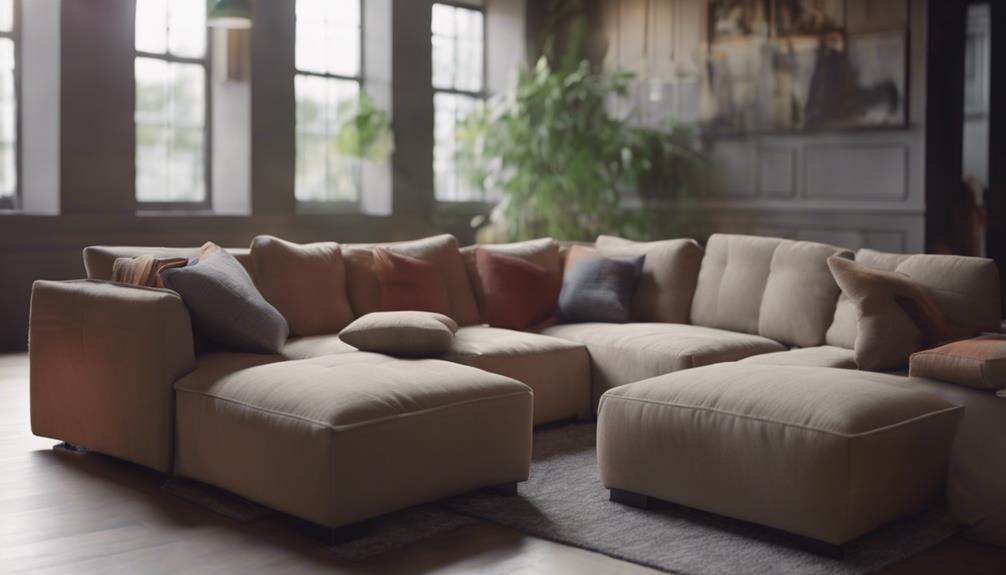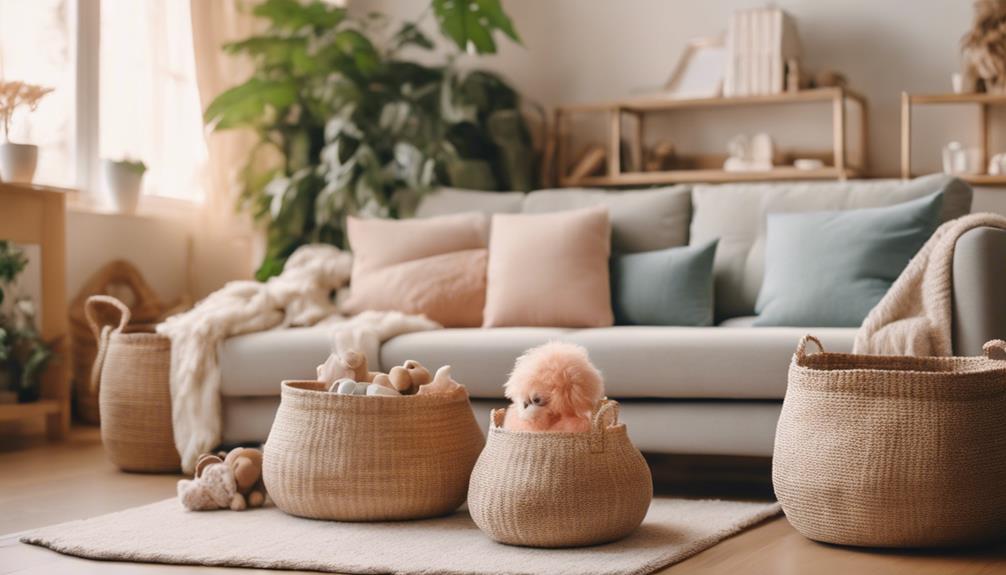Country farmhouse room decor is all about creating a cozy and inviting space where you can unwind. Start by using soft, neutral tones to enhance warmth and incorporate natural materials like wood and metal for authenticity. Layer different textures with textiles to add depth and comfort. Choose essential fixtures, like a reclaimed wood coffee table or a vintage iron bed frame, to anchor your design. Unique lighting fixtures and charming decorative elements, like mason jar arrangements, elevate the aesthetic. If you're curious about more stylish tips and ideas, there's plenty waiting to inspire your farmhouse journey!
Key Elements
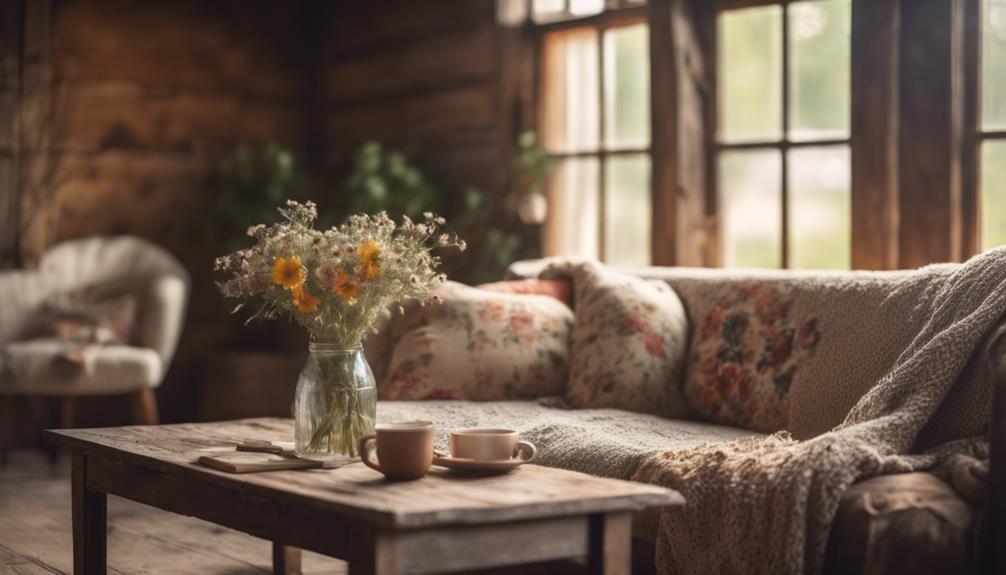
When creating a country farmhouse vibe, pay close attention to your color scheme, materials, and textures.
Opt for soft, neutral tones to create a warm and inviting atmosphere while choosing natural materials like wood and metal to enhance authenticity.
Layering different textures with textiles can further elevate the coziness of your space, making it feel truly homely.
Color Scheme
What colors can transform your country farmhouse into a warm and inviting retreat?
Start with neutral tones like beige, gray, cream, and taupe. These colors create a calming atmosphere that instantly makes your space feel more welcoming. Pair them with soft whites and earthy hues to enhance natural light and give your rooms a spacious feel.
Don't shy away from incorporating accent colors like blue and green. These hues can add depth and warmth to your overall color palette without overwhelming the serene vibe that neutral tones provide. They also complement natural wood tones beautifully, allowing for a harmonious blend throughout your decor.
For a cohesive look, consider using vintage-inspired decor elements that resonate with your chosen color palette. These pieces can tie your design together, creating a charming and inviting environment.
Plus, you can easily refresh your space with seasonal changes by swapping out accessories in different colors. This not only keeps your farmhouse looking current but also lets you express your creativity.
Materials
To enhance your country farmhouse's inviting atmosphere, focus on incorporating key materials that reflect its rustic charm and warmth.
Start with weathered wood, a quintessential element that adds character and authenticity to your space. Consider using reclaimed materials, like old barn wood or vintage doors, to create unique furnishings that contribute to that charming aesthetic.
Next, bring in soft textiles. Fabrics like cotton and linen are perfect for bedding and upholstery, creating a cozy atmosphere through layered patterns. Stick to neutral tones—think whites, beiges, and grays—to establish a serene backdrop that allows your decor to shine. This palette makes it easy to integrate vintage accessories, adding personality and history to your rooms.
Lastly, don't forget about greenery. Incorporating potted plants or fresh flowers introduces an organic touch that enhances your farmhouse's aesthetic while promoting a connection with nature.
Textures
Textures play an essential role in crafting the inviting and cozy atmosphere characteristic of country farmhouse decor. By combining soft textiles like linen and cotton with rustic materials such as weathered wood and reclaimed metal, you can create depth and warmth in your space.
Layered textures are key—think plush rugs, knitted throws, and woven baskets that enhance the tactile experience and contribute to a cozy environment.
Incorporating a variety of textures, like smooth ceramics alongside rough-hewn wood and soft fabrics, adds visual interest and character while maintaining a cohesive aesthetic. Don't shy away from using natural fibers like jute and sisal for rugs and accents; they provide an earthy, organic feel that perfectly complements the rustic theme.
Mixing textures also plays a significant role. Pairing leather furniture with soft cotton or wool textiles creates a balanced and inviting atmosphere, encouraging relaxation and comfort in your farmhouse living spaces.
Essential Fixtures and Furniture

When you're furnishing your country farmhouse, choosing essential fixtures and furniture is key to creating that cozy vibe.
A reclaimed wood coffee table can serve as a beautiful centerpiece, while a vintage iron bed frame adds a touch of charm to your bedroom.
Don't forget a farmhouse-style armchair for a perfect spot to relax and enjoy the rustic atmosphere.
Reclaimed Wood Coffee Table
Reclaimed wood coffee tables often bring a rustic charm to your living space, showcasing unique grains and imperfections that highlight their rich history. These tables aren't just beautiful; they're environmentally friendly, repurposing wood from old barns, factories, or furniture. By choosing a reclaimed wood coffee table, you're supporting sustainability and reducing waste.
The durability of reclaimed wood makes it an excellent choice for a coffee table, allowing it to withstand everyday use while retaining its aesthetic appeal. You'll find that many of these tables feature artisanal craftsmanship, incorporating live edges or mixed materials that enhance their visual interest and uniqueness. This craftsmanship guarantees that no two tables are alike, adding a personal touch to your farmhouse decor.
A reclaimed wood coffee table serves as a versatile fixture in your home, fitting seamlessly into various styles, from modern rustic to traditional farmhouse aesthetics. Whether you're hosting friends or enjoying a quiet evening, this piece will be a focal point, inviting warmth and conversation.
Invest in a reclaimed wood coffee table, and enjoy a piece of history that complements your cozy, aesthetic living space.
Vintage Iron Bed Frame
A vintage iron bed frame adds a timeless charm to your farmhouse bedroom, beautifully complementing the rustic appeal of reclaimed wood furniture. This bed frame serves as a stunning centerpiece, showcasing intricate designs that blend elegance with the cozy farmhouse vibe you love.
Its durable construction guarantees it stands the test of time, making it a practical choice for families who value both style and functionality.
Available in various finishes, such as classic black, white, or distressed hues, a vintage iron bed frame can fit seamlessly into diverse color palettes, enhancing the aesthetic appeal of your space.
You can easily dress it up with layered quilts and patterned throws, creating a warm and inviting atmosphere that's perfect for snuggling up on chilly nights.
Farmhouse-style Armchair
Farmhouse-style armchairs effortlessly blend comfort and charm, making them essential fixtures in any rustic living space. These armchairs often feature slipcovers in neutral tones, providing relaxed and easy-to-clean options that fit seamlessly into the farmhouse aesthetic. You'll find comfortable seating with oversized, cushioned designs that invite you to sink in and relax after a long day.
The use of natural fabrics like linen and cotton enhances the cozy atmosphere while adding a touch of casual elegance. Many armchairs incorporate weathered wood or distressed finishes, amplifying the rustic charm that defines farmhouse decor.
To make your space truly unique, don't hesitate to add eclectic elements, such as patterned throw pillows or vintage-inspired designs. These accents serve as statement pieces, drawing the eye and sparking conversation.
Whether you're curling up with a good book or hosting friends, a farmhouse-style armchair provides the perfect blend of style and comfort.
Embrace this timeless piece to create an inviting and warm atmosphere in your home. With the right armchair, you'll find that comfort and aesthetics go hand in hand, enriching your living space in a delightful way.
Lighting Ideas
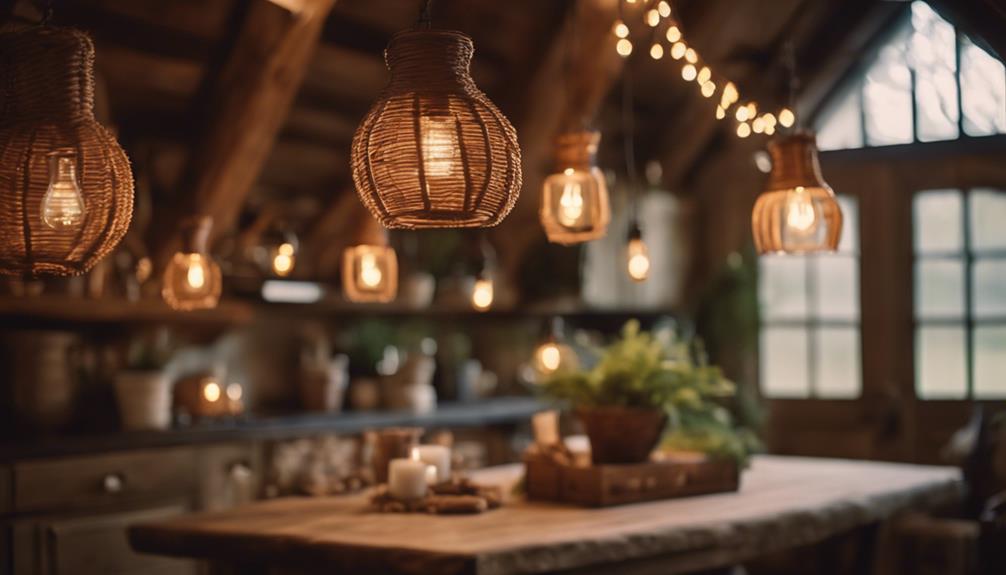
When it comes to lighting in your farmhouse, rustic pendant light fixtures and charming Edison bulb designs can really set the mood.
You might also consider vintage lanterns for warmth and antique-style table lamps to enhance the cozy vibe.
These elements not only illuminate your space but also contribute to the overall charm of your decor.
Rustic Pendant Light Fixtures
Rustic pendant light fixtures add warmth and charm to your home, enhancing the farmhouse aesthetic with their unique materials and designs. Often crafted from warm wood, metal, or glass, these fixtures bring character and style to any room. You'll find a variety of options, including industrial, vintage, or distressed finishes, allowing you to choose designs that fit your specific decor theme.
Hanging pendant lights make perfect focal points above kitchen islands, dining tables, or living areas, providing both illumination and visual interest. Many rustic pendant lights feature Edison bulbs or warm-toned LED options, which contribute to a cozy atmosphere while promoting energy efficiency. This thoughtful choice in lighting can transform your space into a welcoming haven.
To create an eclectic look, consider incorporating rustic pendant light fixtures at varying heights. This approach not only enhances the overall design but also maintains a cohesive farmhouse style.
The right lighting can elevate your home decor, making each space feel inviting and full of personality. So, explore your options and find the perfect pendants to illuminate your farmhouse aesthetic beautifully.
Vintage Lanterns for Warmth
Vintage lanterns bring a cozy, inviting glow to any room, effortlessly enhancing your farmhouse decor with their charming presence.
These versatile lighting fixtures serve as both functional elements and decorative accents, adding a rustic charm that complements your style. With warm-toned bulbs, vintage lanterns create a soft illumination that makes spaces feel welcoming and intimate.
You can find vintage lanterns in various materials like wrought iron, glass, and wood, allowing you to choose pieces that align with your specific farmhouse aesthetics—whether modern or traditional.
Consider incorporating them into your design by using lanterns as wall sconces or hanging them from the ceiling; this provides layered lighting options that enhance the overall ambiance of your home.
Don't forget about the versatility of vintage lanterns; they can easily adapt from indoor settings to outdoor spaces, such as porches or patios.
This classic appeal not only adds warmth but also creates a cohesive look throughout your living areas. By integrating vintage lanterns into your farmhouse decor, you'll achieve a cozy atmosphere that everyone will love.
Antique-style Table Lamp
Antique-style table lamps instantly elevate your farmhouse decor with their intricate designs and warm, inviting glow. These charming lighting fixtures often feature materials like brass, wrought iron, or porcelain, each bringing a unique vintage charm to your cozy farmhouse. When you choose warm-toned bulbs for these lamps, they create an atmosphere that's perfect for reading nooks or bedside tables, making your space feel even more inviting.
To enhance the rustic aesthetic of your room, look for lamps with fabric or glass shades that diffuse light softly. This not only brightens up the space but also adds a layer of warmth. You can mix antique-style table lamps with modern lighting fixtures to create a balanced look that highlights the unique character of your decor ideas.
Finding these gems can be fun, as you can often discover antique-style table lamps at thrift stores or flea markets, providing budget-friendly options that infuse vintage flair into your home. Incorporating these pieces will surely make your farmhouse feel cozier and more aesthetically pleasing, transforming it into a welcoming retreat.
Charming Edison Bulb Fixtures
Enhancing your farmhouse decor with charming Edison bulb fixtures creates a warm and inviting ambiance that instantly draws attention. These vintage-inspired designs, featuring exposed filaments, emit a cozy atmosphere perfect for any charming farmhouse setting. You can incorporate Edison bulb fixtures in various styles, like pendant lights, chandeliers, or wall sconces, ensuring both functionality and aesthetic appeal.
The versatility of these fixtures allows you to customize your lighting according to your space's overall vibe, whether you prefer rustic or industrial designs. Their unique shapes and sizes can complement other rustic elements, such as wood accents and vintage furnishings, leading to a cohesive and inviting design.
Plus, with energy-efficient options available, you can enjoy the nostalgic look of Edison bulbs without compromising on energy consumption. These modern alternatives offer longer lifespans while maintaining that classic glow.
Decorative Elements
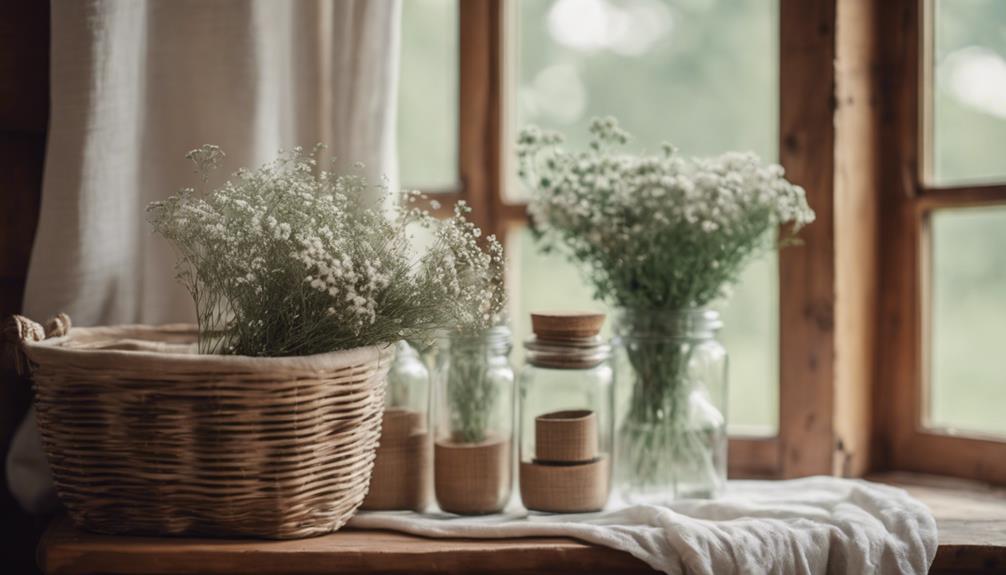
When it comes to decorative elements, think about how mason jar flower arrangements can brighten up your space while adding a touch of rustic charm.
Woven wall hangings and framed vintage botanical prints also infuse your decor with texture and personality.
These pieces not only enhance the farmhouse aesthetic but also make your home feel warm and inviting.
Mason Jar Flower Arrangements
Mason jar flower arrangements bring a charming and rustic touch to your country farmhouse decor. These versatile mason jars can easily transform into delightful vases for both fresh and dried flowers, enhancing the cozy atmosphere of your home.
For DIY enthusiasts, customizing these jars is a fun project; you can paint, wrap them in twine, or adorn them with lace to match your seasonal themes or personal style.
Arranging wildflowers or seasonal blooms in mason jars creates a welcoming feel, making them perfect for kitchen tables, living rooms, or outdoor gatherings. You can elevate the aesthetic by grouping mason jar arrangements of varying heights, which adds visual interest and a dynamic display in any room.
Additionally, using mason jars for flower arrangements promotes sustainable decor, as it repurposes glass containers that might otherwise be discarded. By choosing mason jars, you not only enhance your decor but also contribute to a more environmentally friendly lifestyle.
Woven Wall Hanging
Woven wall hangings instantly add texture and warmth to your country farmhouse decor, making any space feel more inviting. These decorative elements are perfect for enhancing the cozy aesthetic you're aiming for. Crafted from natural fibers like cotton, jute, or wool, woven wall hangings align beautifully with the farmhouse emphasis on organic materials.
You can easily customize these pieces in size and design to reflect your personal style. Choose options that feature neutral tones and earthy colors, as they complement the calming color palette typical of farmhouse interiors. A well-placed woven wall hanging can serve as a stunning focal point, drawing the eye and adding depth to your decor.
Don't hesitate to layer your woven wall hangings with other wall decor elements, such as framed art or wooden signs. This layering creates a visually rich and inviting atmosphere, making your home feel even cozier. Whether you opt for intricate patterns or simple weaves, these hangings are a fantastic way to express your style while enhancing the warmth of your country farmhouse.
Framed Vintage Botanical Prints
Framed vintage botanical prints bring nature-inspired elegance to your country farmhouse decor, enhancing its rustic charm. These prints often showcase intricate illustrations and vibrant colors, making them enchanting focal points on your walls or shelves. To reinforce the vintage aesthetic, consider using antique frames or distressed finishes that seamlessly blend with other farmhouse elements.
You can create a stunning gallery wall arrangement by grouping multiple botanical prints together. This approach not only adds visual interest but also creates a cohesive and inviting atmosphere throughout the room. The interplay of different frame styles and sizes can further enhance the rustic charm.
One of the best features of framed vintage botanical prints is their versatility. You can easily update your decor to reflect seasonal changes, swapping out prints to capture the beauty of nature throughout the year. Whether you choose spring blossoms or autumn leaves, these prints allow you to celebrate the changing seasons in a stylish way.
Incorporating framed vintage botanical prints into your country farmhouse decor guarantees a timeless and charming look that everyone will appreciate.
Flooring
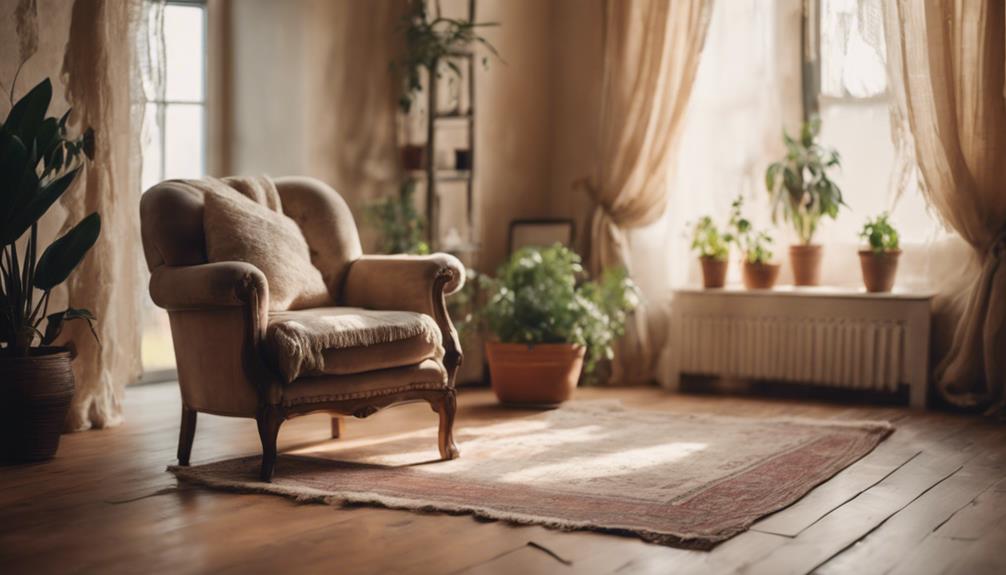
When it comes to flooring in your country farmhouse, you'll want options that enhance the rustic charm while offering durability.
Consider reclaimed barnwood plank flooring for its authentic look, or herringbone patterned tile flooring for a stylish twist.
Hand-scraped maple hardwood flooring can also add warmth and character to your space, making it feel inviting and homey.
Reclaimed Barnwood Plank Flooring
Reclaimed barnwood plank flooring brings a unique, rustic charm to your farmhouse decor, showcasing the character of wood that's steeped in history. Each plank, hand-selected for its distinct grain patterns and weathered finish, adds individuality to your space, enhancing the rustic aesthetic you love. This flooring type perfectly embodies farmhouse style while promoting sustainability by repurposing materials that might otherwise go to waste.
Not only does reclaimed barnwood provide a warm, inviting atmosphere, but it also offers exceptional durability. The aging process hardens the wood, making it resistant to wear and tear, so you can enjoy your beautiful floors for years to come. You'll appreciate the natural charm of the reclaimed wood as it transforms your home into a cozy retreat.
Additionally, you can customize the look of your flooring with various stains and colors, ensuring it fits seamlessly with your decor preferences. Whether you wish to keep its original finish or enhance its beauty with a new stain, reclaimed barnwood plank flooring is an excellent choice for creating a cozy, stylish environment that captures the essence of farmhouse living.
Herringbone Patterned Tile Flooring
Herringbone patterned tile flooring adds a striking visual element to your farmhouse, enhancing the rustic charm while offering a modern twist. This dynamic design features rectangular tiles arranged in a zigzag formation, creating movement and depth in any room. You'll find that this flooring choice fits perfectly with country farmhouse aesthetics, effortlessly blending with rustic elements like wood beams and vintage decor.
Available in various materials such as ceramic, porcelain, and natural stone, herringbone tiles allow you to choose the best fit for your style and durability needs. Whether you're aiming for a cozy farmhouse setting in the kitchen or a stylish entryway, this flooring elevates the space.
One of the best aspects of herringbone patterned tile flooring is its low maintenance. Resistant to moisture and stains, it's ideal for high-traffic areas, ensuring your home remains welcoming and functional.
Plus, with its classic look, you won't have to worry about it going out of style anytime soon. Embrace the charm of herringbone tiles and transform your farmhouse into a cozy yet chic haven that everyone will love.
Hand-scraped Maple Hardwood Flooring
Enhancing the rustic charm of your farmhouse, hand-scraped maple hardwood flooring offers a textured surface that beautifully mimics reclaimed wood. This flooring choice not only adds character but also elevates your cozy interiors with its warm, light to medium brown hues and subtle grain patterns.
You'll appreciate the durability of maple hardwood, making it an ideal selection for high-traffic areas, ensuring your floors withstand the wear and tear of daily life.
One of the standout features of hand-scraped finishes is their ability to conceal minor scratches and dents, simplifying maintenance while preserving that charming rustic appearance over time.
When it comes to modern farmhouse designs, hand-scraped maple hardwood flooring is a sought-after element that can greatly increase your home's value.
Conclusion
Incorporating country farmhouse decor into your space can create a warm and inviting atmosphere that everyone will adore.
By focusing on key elements, essential fixtures, and thoughtful lighting, you'll transform your room into a cozy retreat.
Don't forget to add personal touches with decorative elements and choose the right flooring to enhance the overall aesthetic.
Embrace these ideas, and you'll enjoy a beautiful, farmhouse-inspired room that radiates charm and comfort for you and your guests.
